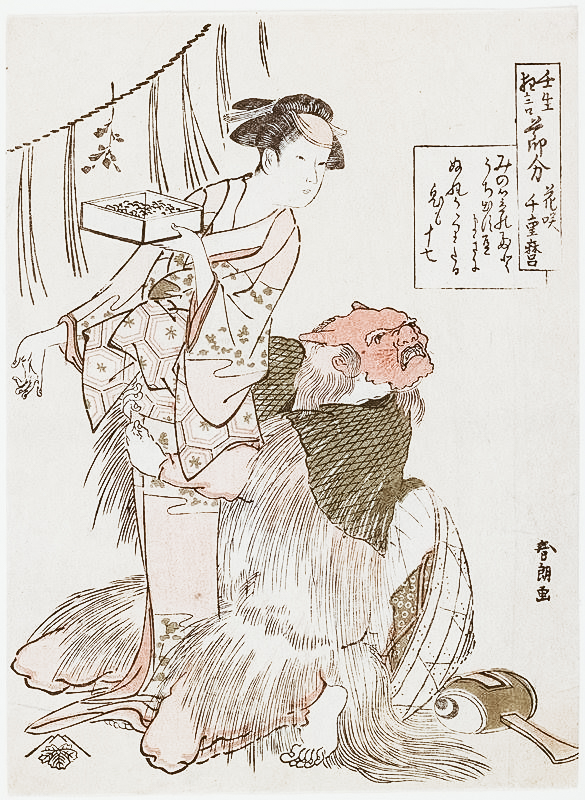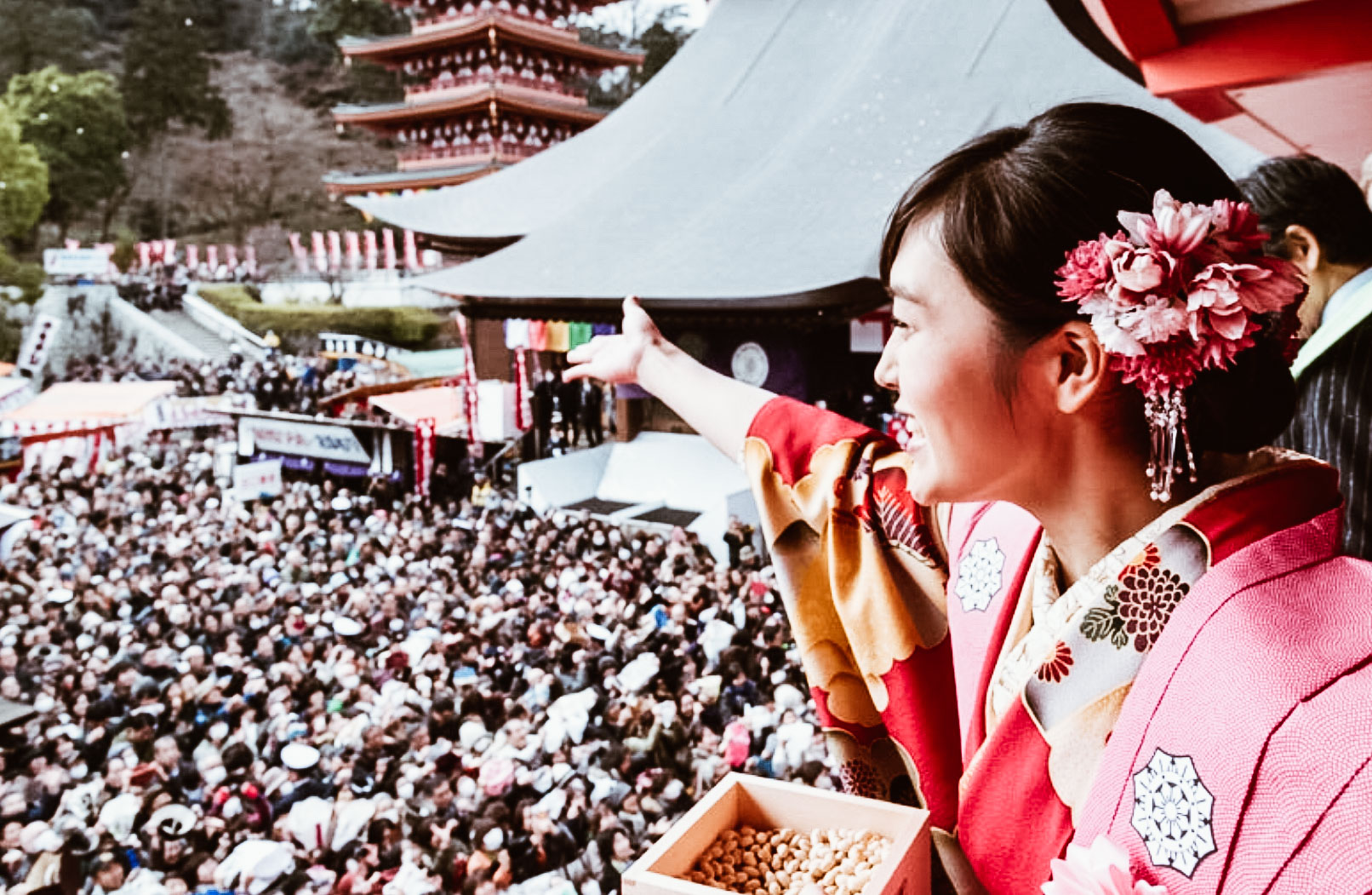Japan Folklore: Setsubun, how to drive away the demons of winter to welcome spring

photo credits: pinterest.it
Traditional Japanese culture has always been characterized by a constant and loving observation of the natural world, its manifestations and its seasonal cycles. Therefore, the attention given to spring, the special moment when nature awakens in all its creatures the necessity of renewal, must not marvel.
This season is celebrated in Japan with the haru matsuri (春祭, spring festival), a set of events whose beginning is marked by the occurrence of Setsubun (節 分). In the traditional Japanese lunisolar calendar, in fact, every change of season is introduced by a day called, indeed, setsubun (literally “division of the seasons”). Spring setsubun, which falls on 3 February, represents the last day of winter and the day before the start of the new season. It marks the transition from “Taikan” (大寒, big cold) to “Risshun” (立春, first day of spring) and is therefore the most favorable moment for a special “cleaning” from winter burdens, which will drive away evil spirits and favor the entrance of the new life-giving energy. This is the meaning of the traditional “demon expulsion” that takes place on this day through different rituals and customs.

photo credits: pinimg.com
Ancient rituals and family fun
The most famous ritual is undoubtedly the mamemaki (豆 撒 き), which is the launch of soy beans. In the domestic sphere it is entrusted to Toshi Otoko (年 男, man of the year), that is the man of the family of the zodiacal sign of the lunar year entering or in his absence the oldest of the house. He has the task of driving out the harmful spirits and negativities from the house and the new year that is about to start by throwing around irimame (炒 り 豆, toasted soy beans) to the cry of “Oni wa soto! Fuku wa uchi! (鬼は外! 福は内, “Outside the demons! Inside fortune!”). In alternative, he can hurl the beans at another member of the family who plays the part of the demon wearing a mask of oni (Japanese folklore ogres). Subsequently, each member of the family must collect and eat a number of beans corresponding to their age plus one to ensure a year of success and good health (in the popular tradition, in fact, the demons are considered carriers of natural disasters and diseases).
When the oni is expelled, it is necessary to keep the evil spirits away from the house. For this reason it is possible to see in this period of the year some very special amulets, the Hiiragi Iwashi (柊 鰯), exposed at the entrance of the houses. These are holly branches that have the head of a dried sardine skewered on the end, sometimes complemented by pieces of garlic or onion, which have the purpose of keeping demons away, scared by the thorns and the pungent odor emanating from these talismans.
In both cases it is a tradition that has its roots in antiquity. Nowadays it is possible to buy “Setsubun sets” – made of oni masks and roasted beans – in any combini, but in reality the mamemaki custom would have originated in the Muromachi period (1392-1573) and seems to be inspired to an ancient legend, whose plot is still represented in the form of pantomime in the temple of Mibu-dera in Kyoto. Here the kyogen (ancient Japanese theatrical form) titled “Setsubun” is repeated several times during the day and it is said that it is sufficient to watch it to be purified by any negative or evil spirit. Its plot follows the folk tale that tells of an ogre who, in human form, goes one day to visit a widow. Thanks to its magic hammer, the ogre makes a beautiful kimono, which attracts the widow’s attention. Eager to take possession not only of the kimono but also of the magic hammer, she decides to get him drunk to be able to steal them both. The ogre, however, aware of the theft, reveals his demonic nature and attacks the woman, who defends herself with the first thing that is within reach: a handful of soy beans. The oni, wounded but again in possession of his goods, flees leaving the widow safe and sound and perhaps a little wiser.

photo credits: toyokeizai.net
Knowing how to look in the right direction
A tradition of more recent origins, born in Osaka but later spread to the rest of the country, is instead linked to the ehōmaki (恵 方 巻, scroll of lucky direction). In this case, to ensure that the good luck is on our side in the year that is about to begin, it is necessary to eat a special sushi roll in a single solution, without interruptions and in silence, facing the lucky direction of the year. The act is less simple than it may seem, considering that the ehōmaki is much more often than a common sushi roll (having to contain seven ingredients to propitiate the seven gods of luck) and is 20 centimeters long. It is not worth eating it cut into pieces, because doing so would also cut luck. To perform the ritual correctly, it is therefore necessary to arm yourself with concentration, determination and a precise compass. For those interested in experimenting with this custom, the most common ingredients to obtain for the filling are cucumber, surimi, salmon, tuna, anago (sea eel), tamagoyaki (Japanese omelette), dried kanpyo strips and seasoned (Japanese pumpkin) and shiitake mushrooms, as well as rice and nori seaweed, while the lucky direction for 2019 is East-North East.

photo credits: shinsenhino.com
Festive temples
The Setsubun can be celebrated in a domestic environment or at least in a private dimension, with relatives and friends, but it is also and above all a recurrence to be lived in community. For example, schools often organize moments of recreation for children, who wear oni masks or have fun chasing adults dressed as demons while hurling beans against them. But it is especially in the temples that it is possible to experience the collective dimension of the party, participating in the events specially created for this day. First of all, of course, the mamemaki, carried out by the monks who throw soy beans from the top of the stages on the crowd gathered for the event. In some temples more shifts are organized for this ritual, reserving some special ones for children, who in addition to the beans receive sweets or small gifts. In addition to the monks, celebrities are often present, such as sports champions, personalities of the entertainment world, actors of the kabuki theater, geisha and maiko, television celebrities, who add a note of attractive glamor to traditional festivities. Among the latter we must remember the theatrical performances, the various purification ceremonies or even the striking archery performances, in which the archers throw their arrows at targets that have demon-like features.
In short, Setsubun is the ideal day for those who wish to live in company a start of the year that helps to renew their energies and for families who have the opportunity to spend a moment of joy together, something that always remains the best talisman against all evil at every latitude.
Share this:
- Click to share on Facebook (Opens in new window)
- Click to share on Twitter (Opens in new window)
- Click to share on Tumblr (Opens in new window)
- Click to share on Pinterest (Opens in new window)
- Click to share on Telegram (Opens in new window)
- Click to share on WhatsApp (Opens in new window)
- Click to share on Reddit (Opens in new window)
- Click to print (Opens in new window)






